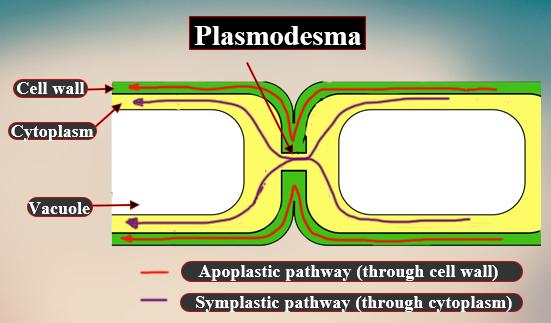
Which of the following structures between two adjacent cells is a transport pathway?
(a) Plastoquinones
(b) Endoplasmic reticulum
(c) Plasmalemma
(d) Plasmodesmata
Answer
496.2k+ views
Hint: This plays a major role in signaling and transport mechanisms like passive transport of macromolecules and active transport of macromolecules. This is only present in plant cells and absent in animal cells.
Complete answer:
Plasmodesmata are tubular extensions of the plasma membrane, which may vary from 40 to 50 nm in diameter, that transverse the cell wall and connect the cytoplasm of adjacent cells in plants. Intracellular transport of solutes through plasmodesmata is called symplastic transport. It consists of pores and channels that help in transportation.
Based on formation there are two types of plasmodesmata:
- Primary plasmodesmata
- Secondary plasmodesmata

- Primary plasmodesmata form during cytokinesis when Golgi derived containing cell wall precursors fuses to form the cell plate.
- Development of primary plasmodesmata thus provides direct continuity and communication between cells that are derived from the same mother cell.
- Secondary plasmodesmata arise either by evagination of the plasma membrane at the cell surface or by branching from primary plasmodesmata.
- Secondary plasmodesmata form between cells after cell walls have been deposited.
- Development of secondary plasmodesmata allows symplastic continuity between cells that are not clonally related.
So the correct answer is, ‘(d) Plasmodesmata.’
Note:
- Plasmodesmata serve as directors of plant growth hormones and development and play an important role in determining a program of cell differentiation, such as sealing off the root and stem epidermal cells from the rest of the plants.
- The function of plasmodesmata are as follows:
Plasmodesmata transport gibberellic acid in algae.
Initiation of wound response in plants.
Control turgor pressure.
Complete answer:
Plasmodesmata are tubular extensions of the plasma membrane, which may vary from 40 to 50 nm in diameter, that transverse the cell wall and connect the cytoplasm of adjacent cells in plants. Intracellular transport of solutes through plasmodesmata is called symplastic transport. It consists of pores and channels that help in transportation.
Based on formation there are two types of plasmodesmata:
- Primary plasmodesmata
- Secondary plasmodesmata

- Primary plasmodesmata form during cytokinesis when Golgi derived containing cell wall precursors fuses to form the cell plate.
- Development of primary plasmodesmata thus provides direct continuity and communication between cells that are derived from the same mother cell.
- Secondary plasmodesmata arise either by evagination of the plasma membrane at the cell surface or by branching from primary plasmodesmata.
- Secondary plasmodesmata form between cells after cell walls have been deposited.
- Development of secondary plasmodesmata allows symplastic continuity between cells that are not clonally related.
So the correct answer is, ‘(d) Plasmodesmata.’
Note:
- Plasmodesmata serve as directors of plant growth hormones and development and play an important role in determining a program of cell differentiation, such as sealing off the root and stem epidermal cells from the rest of the plants.
- The function of plasmodesmata are as follows:
Plasmodesmata transport gibberellic acid in algae.
Initiation of wound response in plants.
Control turgor pressure.
Recently Updated Pages
Master Class 9 General Knowledge: Engaging Questions & Answers for Success

Master Class 9 English: Engaging Questions & Answers for Success

Master Class 9 Science: Engaging Questions & Answers for Success

Master Class 9 Social Science: Engaging Questions & Answers for Success

Master Class 9 Maths: Engaging Questions & Answers for Success

Class 9 Question and Answer - Your Ultimate Solutions Guide

Trending doubts
State and prove Bernoullis theorem class 11 physics CBSE

Who built the Grand Trunk Road AChandragupta Maurya class 11 social science CBSE

1 ton equals to A 100 kg B 1000 kg C 10 kg D 10000 class 11 physics CBSE

State the laws of reflection of light

One Metric ton is equal to kg A 10000 B 1000 C 100 class 11 physics CBSE

Difference Between Prokaryotic Cells and Eukaryotic Cells




